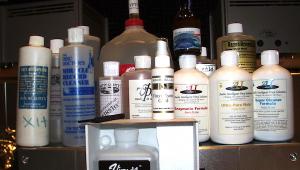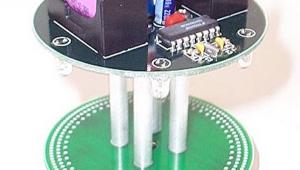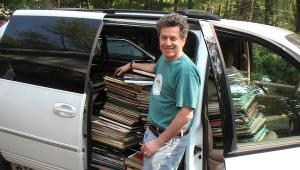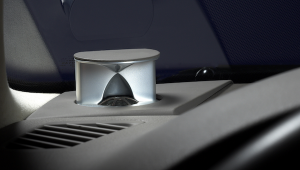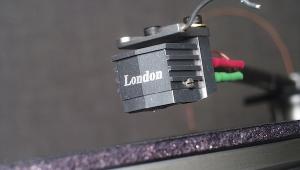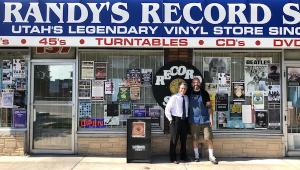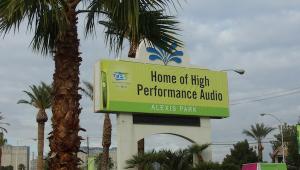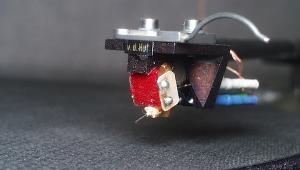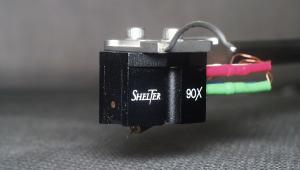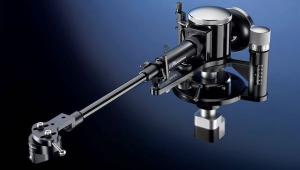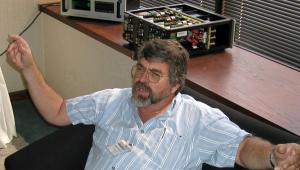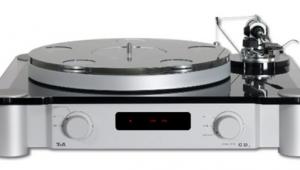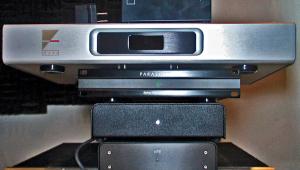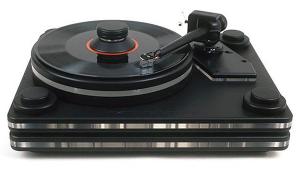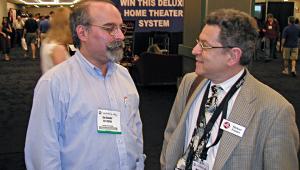Analog Corner #86
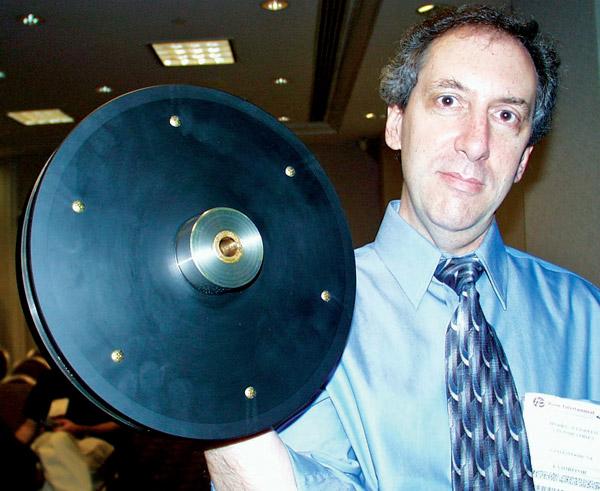
Was I spoiled by the proliferation of analog gear at the High End 2002 show in Frankfurt, Germany? Nah. Home Entertainment 2002 just wasn't a very analog show. Some new and exciting gear appeared, and there were plenty of turntables playing vinyl. But the agenda of HE2002 was multichannel sound and home theater. That's what the organizers wanted, and, at least on the surface, that's what they got. They also got almost 15,000 attendees—a major increase over last year's turnout at the same venue, the New York Hilton. By all indications, the Show was a hit. The elevators worked this time, and no one got trampled, despite the upsurge in attendance.
More big video names participated this year, including Philips, Samsung, Sony, Sharp, and Zenith; there were more seminars about home theater, HDTV, and multichannel DVD-Audio and SACD, and one fewer about analog (not my choice). What that means is that there were no seminars about analog. Don't think I didn't hear about it in the crowded upstairs corridors, where the two-channel audio displays were concentrated.
Stereophile's "Ask the Editors" session, once a highlight of these shows, was relegated to the Friday-morning gulag instead of the prime Saturday spot, which went instead to its stablemate, Home Theater magazine. There was even a seminar on "home networking," one of the most oversold, overstuffed, and unappealing ideas to come down the pike since MP3 as successor to CD. Like the dot.comers who predicted the end of bricks-and-mortar retailing during the boom years of the mid-'90s, the home networkers envision a "wired home" of the future with PCs and servers controlling everything, and a video screen as the hearth. Never mind what consumers think now, they'll just have to come along, the thinking goes.
Yet, as the headline of a recent Reuters (feh!) Internet Report stated, "Consumers Snub Costs, Complexity of Home Networking": " 'Nobody's convinced consumers they [devices] all need to talk to each other; the stereo to the PC to the game box,' said Charles Roussel, a Boston-based partner in the high-tech group of Accenture, formerly Andersen Consulting," the story reported.
No one ever will, in my opinion. Yes, a refrigerator can be designed to go online and order replacement food as you remove and consume it, but who wants or needs that? To most consumers, computers and home theaters, like refrigerators, are appliances. Complicated ones. "They think 'If I can't make my PC work, or my DVD, and I link them together, my house will explode,'" Roussel went on. No wonder 57% of consumers surveyed for that story said they don't have, nor do they want, a wired home network. The number was up to 66% for wireless.
Folks don't want all of their home electronics tied together into one complex knot just because it can be done. My kitchen has running water, but that doesn't mean I want to install a toilet in the middle of it just because I could. And as much as I love watching movies at home on a big screen with 7.1-channel sound, I don't think home theater will ever attain audio's "hobby status," or incite the passions of its devotees, the way hi-fi does and has for more than 50 years.
That's why few of us on the Stereophile "Ask the Editors" panel were surprised by the SRO crowd that gathered on that workday morning. And fewer were surprised by the response to panel moderator John Atkinson's question: "How many of you still have turntables and still play records?" In the year 2002, the overwhelming majority of hands went up. Put that in your home network and smoke it.
New and Exciting
Still in the prototype stage, VPI's TNT HR-X turntable was previewed at HE2002 in the Toys from the Attic room. The aluminum-slab plinth shown in the photo has since been changed to an aluminum-on-acrylic sandwich for practical, aesthetic, and possibly sonic considerations. When I spoke to designer Harry Weisfeld shortly after the Show, he told me the motor assembly was already in production, and that he'd signed the purchase order for the first batch of plinths that day.
The HR-X's four-poster design is similar to the current TNT's, but the overall footprint has been greatly reduced to a more easily manageable 25" by 19", thanks to a large plinth cutout and the new compact, self-contained, "vertically configured" isolated drive-unit containing two smaller 24-pole motors flanking a large, flywheel. The motors are driven 7.5° out of phase from each other, which is said to give the essentially cogless performance of a single 48-pole motor. With both motors driving only the flywheel, and the flywheel driving only the platter, sufficient isolation is said to be provided to nullify the potential two-motor negatives of added noise and "jitter" caused by machining (in)tolerances in the belt and pulley.
Another big change in TNT HR-X from the current TNT is the bearing design and its interface with the platter. The current bearing features a standard ball/thrust plate with the platter riding on an integral shaft flange via three adjustable, pointed set screws. The new bearing appears to be a far more stable inverted design, with the 60-Rockwell–hardness, stainless-steel shaft—hardened, ground, and polished—anchored to a recess in the plinth. A larger tungsten-carbide ball mounted atop the shaft rides on a soft Teflon thrust plate fitted inside the 28-lb platter, a stainless-steel-on-acrylic sandwich laminated and bolted together. The platter rotates around one long oil-impregnated brass sleeve set inside a stainless-steel boss mounted to the platter bottom. The sleeve is cut out in the center so the shaft contacts only its top and bottom. When Weisfeld first assembled the bearing, it fit so securely that he couldn't remove the platter. His machinist had to fashion a special fist-sized tool that screws onto the spindle. Weisfeld told me that the idea for the Teflon thrust plate came from an impressive-sounding, superbly built Kenwood L07D turntable he'd come across that cost $2900 in 1980. After 22 years of use, the Kenwood's thrust plate exhibited little wear.
The new 'table will have a removable armboard, Weisfeld told me after the Show. He then said he'd been toying with the idea of trying a totally independent arm platform that would sit in a plinth cutout, thus isolating the arm from any bearing noise. The tradeoff, of course, is that the arm stand would then be sitting on the same platform as the motor assembly. Another option might be to offer the TNT HR-X with or without the air-bladder suspension. The "without" version would allow for the use of cones inside the towers, centered with an elastomer doughnut, for "a totally different sound," said Weisfeld. He's also considering making the platter slightly oversized to accommodate a record clamp with an automatically centered perimeter. He's certain the TNT HR-X's final cost will be under $10,000. The 'table has that "right" vibe about it; I hope to get one for review ASAP.
Oddly enough, many of the ideas used in the HR-X resulted from the development of the $1500 Scout, which comes complete with JMW-9 arm. To keep the Scout's costs down, Weisfeld resorted to simplicity in the bearing assembly and in the arm/plinth interface. The resulting sound so intrigued him that he decided to apply some of the ideas to the big 'table.
Aesthetix (distributed by Musical Surroundings) demoed finished versions of the tubed Saturn Series of electronics, shown only in prototype form at CES: the Rhea phono stage ($3500), Calypso line stage ($4500), and Janus full-function preamp ($6500). The Rhea has selectable gain up to 70dB and fully balanced internal circuitry, with gain and loading adjustable by remote control. How great is that? It uses 12AX7 and 6922 tubes and features three independently configurable phono inputs and a built-in cartridge demagnetizer. The Calypso, which also uses 12AX7 and 6922 tubes, offers balanced and unbalanced inputs and outputs, home theater processor bypass, and remote control, while the Janus combines on the same chassis a version of the Rhea with a single phono input and the Calypso line stage. Three very ambitious, reasonably priced products.
In the same Musical Surroundings-Halcro-Rockport room was the new 0.6mV Clearaudio Harmony cartridge, available with a wood or magnesium body for $6000. Such a curious assemblage of manufacturers brings me to my second sermonette of this column: a comment on some of the clueless criticism I read online about this Show. On a site whose URL I can't recall, someone wondered why Andy Payor, no fan of the Souther-based Clearaudio tonearm, would show his speakers in conjunction with Clearaudio importer Musical Surroundings. I read other comments criticizing some of the other combinations found in certain rooms, and many criticisms of the sounds heard at the Show and the demo music used.
Participating in the Home Entertainment and Consumer Electronics Shows is extremely expensive: there's the room cost, the shipping costs, the cost of getting the crates from the storage area to the rooms and back (often more expensive than the shipping itself, thanks to the Teamsters), the cost of brochures, of traveling to the location, room and board, theft, breakage, and on and on. The total can easily run to tens of thousands of dollars per participating company. In order to keep these costs down, manufacturers share rooms, and this sometimes leads to strange bedfellows. The Rockport-Halcro combo was a no-brainer, and tonearm duties were shared by the Clearaudio and Graham Engineering 2.2, both of which were mounted on a Clearaudio Maximum Solution turntable. Would Andy Payor have preferred to use his System III Sirius 'table? Do you have to ask?
Another reason you find such odd groupings in rooms is the dealer connection: local dealers often sponsor rooms (while making the manufacturers pay for them), and need to show all of their lines. This sometimes leads to uncomfortable and/or unfortunate combinations. Logic and good sound sometimes take a back seat to exposure.
Given the need to attract a crowd and keep them in the room, most participants are loath to play long, complex pieces of music. Variety is key, and so, unfortunately, is accessibility. If you bring in some 12-tone Webern work, don't expect to hear it, or any piece that runs longer than 10 minutes. Shallow? No. It's a show, and you have to give people what they want. If your tastes run to classical, choose something light and lively if you want to get it played.
All that said, yes—there was too much audiophile tripe. I ran from rooms playing Jennifer Warnes' Famous Blue Raincoat or Rebecca Pidgeon—not that there's anything wrong with either of them, but why not play new and interesting music instead of the same old same old?
As for the sound at the Show, cut these guys some slack. They have very little time to deliver the goods in unfamiliar rooms that are mostly too small, too crowded, and supplied with grungy AC. Yes, some rooms sounded fantastic, but it's not fair to denigrate the guys who couldn't get it to work. In my experience, if the show sound is good, odds are the products are good; if the show sound is bad, you can't draw any conclusions. But if the sound sucks and the host says it sounds great, he's made his own bed, and you have every right to make him lie in it.
Analog-Like News
My Show assignment was to cover analog, but I stretched it to include the "analog-like" as well. Into that category fell ABKCO Records, which used HE2002 to announce that it was reissuing the entire Decca/London Rolling Stones catalog—22 albums in all—on SACDs. ABKCO VP Jody Klein, ABKCO founder Allan B. Klein's son, made the announcement, followed by demos across the hall in Sony's room, equipped with VTL amps and EgglestonWorks speakers. The sound was extremely promising—no surprise, given how the transfers are being made. Klein went back to the original tapes on both sides of the Atlantic to find the ones that sounded best. The tracks were transferred flat to DSD using converters modified by Ed Meitner, and an analog playback deck modified by Mike Spitz of ATR Service Company.
The final mastering of the Stones SACDs was by Bob Ludwig of Gateway Sound in Maine, who told me, "I've got my Well Tempered Turntable with [Manley] Steelhead phono preamp at work as we compare both the original London and Decca pressings on nearly every song (as well as the 1986 CD). We are keeping totally to the spirit (and speed!...and channel assignment!!!) of the original recordings....I've never worked with a record company that is trying like hell to do something as right as humanly possible....I can't tell you how many times I thought we had an approved album when a better source turned up from one of the Stones' personal collection or some place like that and we re-do the whole thing again!...I can say with confidence that there are no electronically reprocessed stereo tracks anywhere and there are plenty of SACD mono tracks!!"
The discs will be SACD/CD hybrids, making them accessible to everyone, nor will ABKCO charge extra for SACD: the single-disc list price will be $18.98. The CD sound will be so much better than the current ABKCO versions that even Stones fans without SACD players will hear the improvement and eat them up. How long before they hear the discs on an SACD player? More important, how long before the Beatles survivors and heirs want a piece of that action? With EMI signed on to SACD, I figure it won't be long.
And rumor has it that 180gm vinyl of the Stones albums, sourced from the DSD masters and pressed at RTI, could be in the works. Where they'll be mastered has yet to be determined, but I'm on cloud 9 over this.
More Analog at HE2002, Including Software
Unless I missed something, the only other analog news at Home Entertainment 2002 was the Magic Diamond moving-coil cartridge ($4650), imported by Walker Audio. Its output is 0.38mV, its tracking range 2.2–2.5gm. Lloyd Walker offered me one to review; when my headshell clears, I'll take him up on it.
The usual turntable suspects were spinning in rooms throughout the Show: the V.Y.G.E.R. Indian Reference, the Walker Proscenium Gold, the Music Hall MMF-5, the Clearaudio Maximum Solution (with the Clearaudio-Souther and Graham 2.2 tonearms), the Immedia RPM 1 with RPM 2 arm, and the Avid Acutus with SME V arm. I spied a vintage EMT transcription turntable and a Goldmund Studietto, as well as a really great-looking one-off carbon-fiber 'table in the Nearfield Acoustics–Tenor Audio room. Even Dave Wilson of Wilson Audio Specialties was spinning vinyl and extolling its virtues in his big room on a Well Tempered 'table.
In short, there was plenty of analog, but not plenty of analog news. The only other analog-like news worth mentioning was the launch of VTL's new, groundbreaking, two-chassis Reference preamplifier ($10,000). That was on another reporter's beat, but I'm hoping to snag one for review.
Over in the ballroom retail area, vinyl business was exceptionally brisk, according to Acoustic Sounds' Chad Kassem, Sundazed Records' Bob Irwin, Red Trumpet's Rick Flynn, Elusive Disc's Bob Bantz, and Music Direct's Jeff Bizar. Most said they'd surpassed last year's sales by early Saturday. Mobile Fidelity Sound Lab's technical director, John Wood, handed me a test lacquer cut on MoFi's upgraded lathe, and when I got home I found the sound to be exceptionally rich and clean. Hopefully, new MoFi releases will come shortly.
Speaking of which, I ran into Classic Records' Mike Hobson and Collie Brice proudly carrying around test pressings of the two-LP soundtrack album to Vanilla Sky. Hobson is friends with director and vinyl fanatic Cameron Crowe, whose film-production company is called Vinyl Films—hence the appearance on Classic of this soundtrack and the one to Crowe's Almost Famous. The superb packaging includes a four-page, full-sized insert in black-and-white and color featuring candid shots of the stars and crew. I received a copy of the set after the Show, and whatever the source material was for this compilation, the sound is terrific. The eclectic soundtrack includes R.E.M., Paul McCartney (title track), Peter Gabriel, Red House Painters, and Jeff Buckley. I have the double 10" UK import of Radiohead's Kid A, and somehow Classic got "Everything in its Right Place" to sound even cleaner and more dynamic.
Bob Irwin promised I'd be getting the first two Lovin' Spoonful albums on Sundazed LPs (with bonus tracks) after the Show, and test pressings arrived today, along with another package from Classic, containing the label's first 200gm Quiex SV-P (super vinyl profile) pressing: Hank Mobley (Blue Note 1568). The album is almost impossible to find in an original pressing, and when you do, it's impossible to afford. As will all of Classic's Blue Note reissues, this monophonic disc reproduces the original "deep groove" label and non-groove-guard, flat-LP profile. Also included was a 180gm pressing from the same stamper, to compare with the 200gm. Classic claims it's easy to hear the improvement—when I finish this column, I'll give them a listen. I also received the second set of Fantasy OJC LPs from Acoustic Sounds, pressed by RTI on 180gm vinyl: classic jazz titles from Wes Montgomery, John Coltrane, Coleman Hawkins, and others at $20 a pop.
Personally Speaking
The most fun I had at HE2002 was playing a CD-R compilation I'd made using the Boulder phono section, Simon Yorke turntable, Immedia RPM-2 tonearm, and a prototype Lyra Titan cartridge. The first track is the 12" 45rpm version of Led Zeppelin's "Stairway to Heaven" that Classic made but for some reason never released. I'll never forget what happened in the large Tenor Audio–Nearfield room: as the track began, sounding unmistakably better on the Pipedreams speakers than "Stairway" had ever sounded to anyone, the seats began to fill, and by the end of the track the room was SRO. When it ended, there was applause.
I played "Stairway" unannounced in John Rutan's room (he owns Audio Connection in Verona, New Jersey) on the modestly priced Vandersteen Audio 2Ce Signatures, and after just a few bars, John's jaw dropped. "What the hell is that?" he asked.
And so it went. In some rooms the CD-R sounded awful, in others superb, and in those rooms I found myself staying and listening to at least half of the 80-minute disc, with no complaints from the crowd.
Mikey's Best Sound at HE2002
I didn't have time to visit every room because of my duties as Show Spokesperson, but here are my top 11 best-sounding rooms at Home Entertainment 2002:
1) Kharma Ceramique 3.2, Lamm electronics
2) Joseph Audio, Manley electronics
3) Rockport, Halcro, Clearaudio, Graham
4) Pipedreams, Tenor Audio
5) Wilson Audio Specialties, VTL electronics
6) Naim Audio
7) PBN Montana EPS speakers, DarTZeel electronics
8) Merlin, Joule Electra (what else is new?)
9) Vandersteen, Ayre
10) Creek, Epos
11) Meadowlark.
